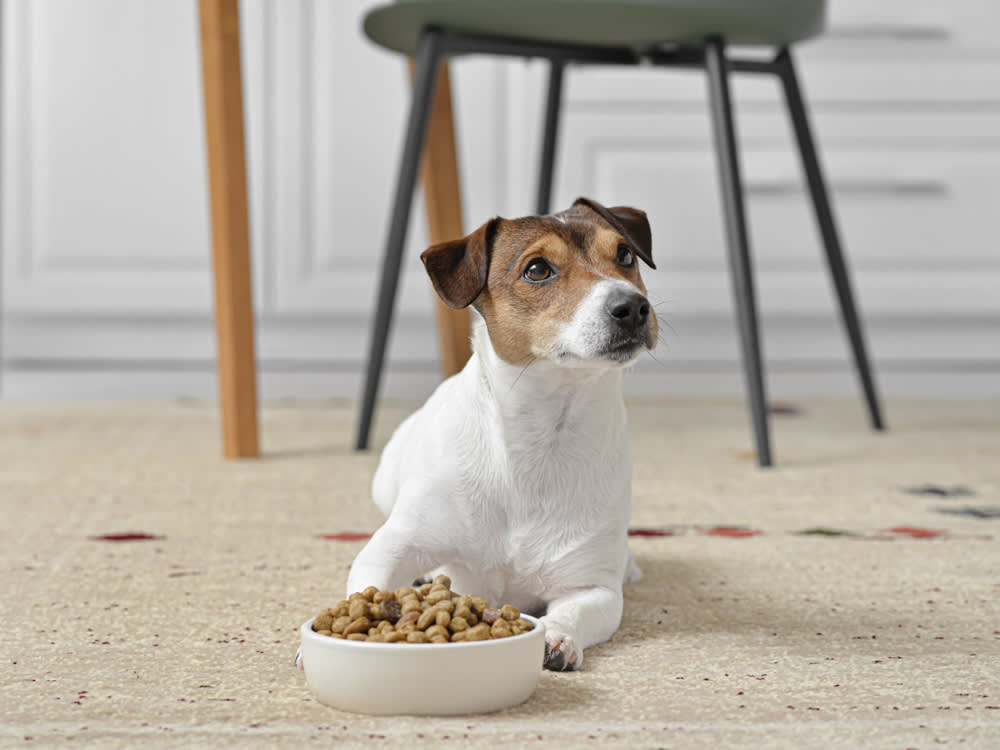Everything You Need to Know About Your Dog’s Gut Microbiome
Microscopic organisms may reveal pathways to better health for your pet.

share article

Your pet wants you to read our newsletter. (Then give them a treat.)
The microbiome is the invisible world of the hundred trillion bacterial, viral and fungal microbes that live on and in your dog — on their fur and skin, behind their ears, and inside their eyelids. The bulk of these minuscule microbes are good guys, gut microbiota that congregate in the digestive tract, where they bolster your pup’s immune system, manufacture vitamins, and digest food to generate nutrients and energy.
Microbial equilibrium is a delicate balancing act, and a broad spectrum of inflammatory and autoimmune diseases is linked to having too many microbes — or too few. For example, researchers know that significantly lower bacterial diversity is found in both people and dogs with chronic inflammatory bowel diseases.
Teasing out the biological interaction of the microorganisms that colonize the body and their role in the well-being of people and pets is a new frontier. Will it be a watershed moment in veterinary medicine? Scientists are hopeful. The human microbiome has become a hot topic in biologic investigations, and canine research is fast catching up. Using stool and tissue samples to isolate microorganisms, researchers are mapping the diversity and normal profile of the microbial community.
Our Microscopic Connection to Dogs
Affected by age, environment, ancestry, evolution, genetics and diet, microbial communities vary widely between species and across individuals within a species. A study suggests that our housemates—including the family dog—may also affect the composition of our personal microbial signature.
If you and your partner kiss, hug and/or share a bed with your dogopens in a new tab, the three of you have more in common than you think. A study conducted by researchers at the University of Colorado, Boulder, revealed several similarities: Adults who share a dog have more similar mouth microbes than those who don’t. Families with dogs have more diverse and different microbial colonies than dogless households. Parents tend to share more kinds of mouth bacteria with their dog than they do their children. And children raised with dogs have a wider variety of microbes than dogless kids.
Whether these spit-swapped microbes serve a purpose or are just passing through is not clear. But research shows that children raised with dogs are less likely to be afflicted by eczema and asthmaopens in a new tab.
The notion that microorganisms in the canine gastrointestinal tract might have unique properties is not new. Early Romans understood the medical value of a well-run therapy dog program. Health temples, the ancient equivalent of modern-day outpatient clinics, were staffed with live-in cynotherapists, gentle dogs who wandered about the grounds greeting patients and licking wounds. Were the dogs healing only psychosomatic injuries? Time and additional research funding will tell.
The idea that our microorganisms may, to some extent, be collectively beneficial is intriguing. People and dogs have been exchanging microbes for at least 30,000 years since the first little cave girl kissed the first proto-dog puppy smack on the muzzle. That’s a long history of sharing. It’s possible that our microorganisms are at least symbiotic and perhaps even played a role in the dramatic domestication of the dog.
Theoretically, many thousands of years ago, a population of carnivorous wolves or ancient proto-dogs (depending on where you stand in the dog-domestication debate) transitioned from a meat-heavy diet to one laden with grain, a consequence of the agrarian revolution.
Scientists know that the acquisition of a new diet is a fundamental driver for the evolution of a new species. When species transition from carnivorous to omnivorous diets, the gut microbial community co-diversifies with the host and drives further evolution. As human diets changed, so too did those of Canis familiaris. Over time, as we incorporated these unique animals into our daily lives, we continued to reshape them.
How Microbiomes Impact Dogs
In humans, autoimmune and inflammatory diseases are on the increase. Scientists can’t verify a similar pattern in dogs because epidemiological studies are rarely conducted in veterinary medicine. Additionally, many autoimmune conditions are diagnosed based on the patient’s subjective description of symptoms.
But this is not the case with itchy skinopens in a new tab. Dogs who scratch themselves incessantly are highly likely to have allergies. When researchers compared microbial colonies on the skin of healthy dogs to those of dogs with allergiesopens in a new tab, they found that non-allergic dogs have much richer and diverse skin microbial communities.
When it comes to proving causality, scientists wisely err on the side of caution. It’s not understood if a change in the microbiome causes certain conditions or if it occurs as a consequence of the conditions. Nor is it absolutely clear that more diversity is better than less. At this point, scientists cannot say with confidence exactly what a healthy microbiome should look like in the dog.
Moreover, what seems logical may not be so. For instance, anyone who has lived with a poop-eating pooch has wondered why some dogs do, and others don’t. Are coprophagic dogsopens in a new tab seeking microbes lacking in their gut? Surprisingly, research involving mice suggests that this might not be the case; coprophagia in germ-free mice is the same as in conventional lab mice.
Other questions arise: Are the microbiomes of individual dog breeds more similar to each other than they are to those of other breeds? And could these isolated microbial communities drive breed-specific ailments?
Jan Suchodolski, DVM, a Texas A&M veterinary medical and biomedical sciences researcher who studies dog and cat gastrointestinal diseases, says that this doesn’t seem to be the case. As he noted, “So far, we do not have any clear evidence that gut microbiomes are more similar within breeds. Environmental influences such as age, diets and antibiotics, and especially the effects of G.I. disease, are larger than any breed effect.
“It may be possible that we missed an effect, as we have not evaluated thousands of animals. But if there were a breed effect, it would probably be very minor. Even within puppies of the same litter, the microbiome shows huge inter-animal variation, so the animal effect is much stronger than any other effect.”
Idiopathic canine inflammatory bowel disease (IBD) is a gastrointestinal condition in which the digestive tract is chronically inflamed. Symptoms include vomiting, diarrhea and weight loss. Dogs with IBD have significantly lower bacterial diversity as well as microbial communities that are distinct from those of healthy dogs. In 2014, Dr. Suchodolski and his colleagues conducted a study of 22 dogs, half of whom suffered from idiopathic IBD. They wanted to know if traditional treatments—steroids and special diets—directly or indirectly created a more robust microbial community.
After treatment, the sick dogs felt a lot better. However, there was no change in their gut microbiota. The researchers concluded, “This study demonstrates intestinal dysbiosis [microbial imbalance] and altered serum metabolite profiles in dogs with IBD. But medical therapy doesn’t seem to affect the intestinal dysbiosis.”
It could be that, rather than triggering the condition, microorganisms are compromised by it. Researchers also suspect that biological environmental stresses are involved in ways not yet understood. Dr. Suchodolski added, “It may be that we need longer follow-up periods of treatments to see potential improvements. Another reasonable theory is that with the current standard therapies—for instance, immunosuppression—we just control clinical signs, but the underlying etiology of the disease is ongoing.”
The Culprits Behind Bacterial Imbalance
When it comes to treating dogs for myriad problems, vets often prescribe antibiotics, and for good reason: antibiotics save lives. But the war on infection sometimes puts good bacteria in the line of fire, too. When assaulted by repeated antibiotic use, some classes of gut bacteria struggle to recover. If the affected bacteria play a pivotal role in autoimmune health, overuse of antibiotics may coincide with a decrease in healthy autoimmune responses.
Antibiotics are not the only culprits. Scientists suspect that in human births, Cesarean deliveries may also contribute to an increase in autoimmune weaknesses. In a vaginal birth, the fetus departs the womb without a single microbe but acquires them by passing through the mother’s birth canal. By the time the newborn takes his first breath, he is covered with colonies of bacteria that kick-start his immune system, establish a healthy digestive tract, help shape his growing brain and even protect him from psychiatric disorders. C-section babies start life without the microbes they would have picked up from vaginal delivery, suggesting that the colonization of the newborn might be delayed.
Medical disorders connected to non-vaginal delivery and the slow introduction of protective bacteria have not been studied in dogs. Considering that a number of breeds with exceptionally flat, wide skulls—such as the Boston Terrier, French Bulldog and Bulldog—must have their pups delivered via C-section, it’s an area that deserves further study.
Or is diet the problem? Commercially manufactured dog chow was introduced in the U.S. in the mid-1920s. By the 1950s, processed dog food like Friskies, Sergeant’s and Purina were widely available through local grocery stores. Today in the U.S., we spend more than $42 billion a year on commercial pet food and treats. The question arises: has the increase in autoimmune diseases paralleled the rise in popularity of processed dog food?
Many pet parents think so and have eliminated or cut back on processed foods in favor of raw meatopens in a new tab and fresh fruits and vegetablesopens in a new tab. Because veterinary practices typically don’t collect this type of empirical data, it has been challenging to uncover the answer, but new research is on the horizon.
Studies show that pets fed diets high in fermentable fibers from vegetable and fruit sources resulted in a significant reduction in end products and toxins associated with chronic renal failure. Researchers saw an increase in beneficial bacteria in dogs, and in cats, researchers observed improvement in kidney health. In Frontiers in Microbiologyopens in a new tab, researchers caution, “While foods can be formulated with ingredients generally recognized to protect against microbiome disturbances, additional study is needed to demonstrate the impact of such changes on disease in individual cats and dogs.”
Developing Therapeutics
Sophisticated DNA sequencing technology has opened up the invisible world to scientific scrutiny. But determining its impact on the host species is difficult and time-consuming. Researchers need to locate and identify a microbe’s fingerprint, then remove a sample and grow it in a culture, a process especially difficult with shyer microbes that are destroyed by oxygen or stomach acid.
To figure out why we get sick and the role microbes play in illness, researchers must first determine how these trillions of organisms interact with each other. And the fact that scientists can prove a problem exists doesn’t mean they know how to fix it.
Developing therapeutic dog foods that target specific vulnerabilities may help but will take time to develop. Although the probiotic movementopens in a new tab may oversell their benefits, probiotics (friendly bacteria like those that live in the gut) are effective in some cases. And prebiotics, foods that encourage the growth of good bacteria already present, may help as well.
The University of Pennsylvania School of Veterinary Medicine recruited dogs with acute symptoms of diarrhea and/or vomiting for a clinical trial that evaluated the role of the intestinal microbiome—the community of “good” bacteria that live in the gut—on chronic gastrointestinal diseases. Therapy included simple diet change, treatment with antibiotics or combination therapy with steroids for more complicated cases.
Researchers collected stool samples at the outset of the study and at different times as the sick dogs began a prescription diet to treat their disease. Using advanced genetic sequencing techniques, the team developed a catalog of the microbes present in the stool, a stand-in for the animals’ gut microbiome. They also collected information about the metabolic products present in the stool.
The study, published in 2019, shared the discovery of key features of the microbiome and associated metabolic products that appeared only in dogs that entered canine chronic enteropathy disease remission. Dogs that responded well to the diet also had fewer harmful bacteria, such as Escherichia coli and Clostridium perfringens, after starting treatment.
Penn Vet researchers anticipate that their study will lay the groundwork for future projects using treatments such as prebiotics, probiotics or fecal transplants (transferring “good” microorganisms from a donor’s healthy stool to the patient’s gastrointestinal tract). Future possibilities are exciting. In the meantime, kiss your dog. It’s good for you in more ways than one.
References
American Society for Microbiology. 2012. Dog-associated house dust protects against respiratory infection linked to asthma.
Dale, C., N. Moran. 2006. Molecular interactions between bacterial symbionts and their hosts. Cell 126(3): 453–465.
Ebino et al. 1987. Coprophagy in the germ-free mouse. Jikken Dobutsu 36(1): 33–37.
Epstein et. al. 2010. Opposing effects of cat and dog ownership and allergic sensitization on eczema in an atopic birth cohort. JPEDS 158(2): 265–271.e5.
Hoffmann et al. 2014. The skin microbiome of healthy and allergic dogs. PLoS ONE 9(1): e83197.
Jakobsson et al. 2014. Decreased gut microbiota diversity, delayed bacteroidetes colonization and reduced Th1 responses in infants delivered by Caesarean section. Gut 63: 559–566.
Ley et al. 2008. Evolution of mammals and their gut microbes. Science 320(5883): 1647–1651.
Minamoto et al. 2015. Alteration of the fecal microbiota and serum metabolite profiles in dogs with idiopathic inflammatory bowel disease. Gut Microbes 6(1): 33–47.
Song, et al. 2013. Cohabitating family members share microbiota with one another and with their dogs. eLife;2:e00458.
Frontiers of Microbiology. 2020. The Effects of Nutrition on the Gastrointestinal Microbiome of Cats and Dogs: Impact on Health and Disease
Jane Brackman, PhD
Jane Brackman, PhD, is an authority on the cultural history of canine domestication and the author of two books on pets in 19th-century America.
Related articles
![Pomeranian stands in front of a yellow bowl of homemade probiotic yogurt]() opens in a new tab
opens in a new tabAre Probiotics Actually Something Your Dog Needs?
Time for a (literal) gut check from four experts.
![Grey cat at looking up from eating on floor at home]() opens in a new tab
opens in a new tabGut Feelings: How to Balance Your Pet’s Microbiome
The mind-gut connection isn’t just for people. Your dog or cat’s gut microbiome plays a big role in their health and well-being.

